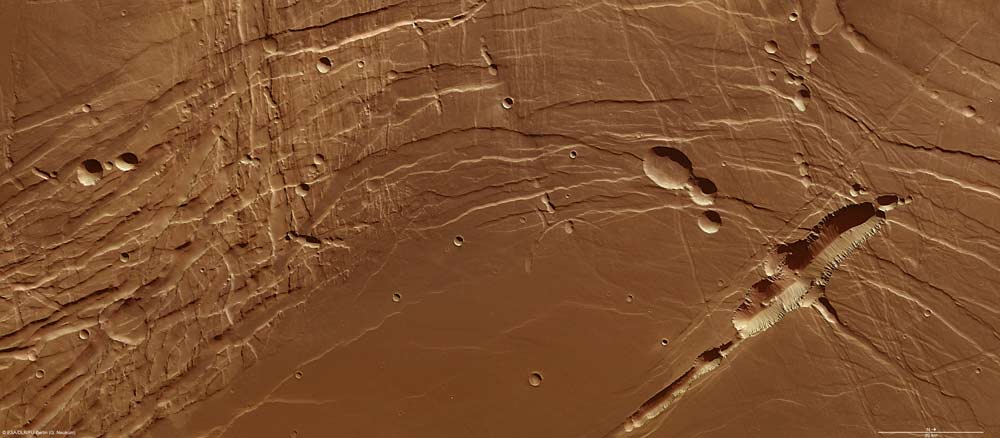Images of Mars' Phoenix Lake Region Reveal Complex Terrain

New images of Mars' Phoenix Lake region show where complex fault lines along a vast Martian plain have resulted in terrain with contrasting light and dark appearances.
The Phoenix Lake region, formally called Phoenicis Lacus, was first spotted by 19th century astronomers, who identified it as a dark spot that resembled a sea. Scientists now know that it is not a body of water, but the southwestern extension of the maze-like Noctis Labyrinthus system of deep valleys.
Phoenicis Lacus has an area of 3,127 square miles (8,100 square kilometers), which is roughly equal to the size of the island of Corsica in the Mediterranean Sea. Only a small portion of the region is visible in the new images, which were obtained with the High-Resolution Stereo Camera on the European Space Agency's Mars Express spacecraft in orbit around the Red Planet. [Image of Phoenicis Lacus]
Phoenicis Lacus was formed by the uplifted terrain of Mars' enormous and volcano-rich Tharsis plateau. The episodes of continuous volcanic activity in the Tharsis region not only lifted the entire plateau, but also deformed Phoenicis Lacus, creating multiple fault lines. Geological stress also carved cliffs and valleys into the landscape over time.
A prominent collapse feature in this region is also visible in the recent images from Mars Express. It appears as a long pit that sinks to a depth of about 1.9 miles (3 km) below the surrounding plains. Its walls give a glimpse of extensive basalt layers and a small field of sand dunes covers the floor.
To identify the various surface features on Mars, planetary scientists assess their brightness, or albedo, which is partly determined by the composition of the surface material. For example, ice is more reflective than rock. The texture of the surface is another factor, with rough surfaces reflecting less sunlight and thus appearing darker than smoother surfaces.
ESA's Mars Express launched on June 3, 2003, and arrived at Mars in December of the same year. The primary objectives of the Mars Express orbiter are to image the entire surface of Mars at high resolution, produce a map of the mineral composition of the planet's surface, and to determine the effect of the Martian atmosphere on the surface.
Get the Space.com Newsletter
Breaking space news, the latest updates on rocket launches, skywatching events and more!
Join our Space Forums to keep talking space on the latest missions, night sky and more! And if you have a news tip, correction or comment, let us know at: community@space.com.

Space.com is the premier source of space exploration, innovation and astronomy news, chronicling (and celebrating) humanity's ongoing expansion across the final frontier. Originally founded in 1999, Space.com is, and always has been, the passion of writers and editors who are space fans and also trained journalists. Our current news team consists of Editor-in-Chief Tariq Malik; Editor Hanneke Weitering, Senior Space Writer Mike Wall; Senior Writer Meghan Bartels; Senior Writer Chelsea Gohd, Senior Writer Tereza Pultarova and Staff Writer Alexander Cox, focusing on e-commerce. Senior Producer Steve Spaleta oversees our space videos, with Diana Whitcroft as our Social Media Editor.











